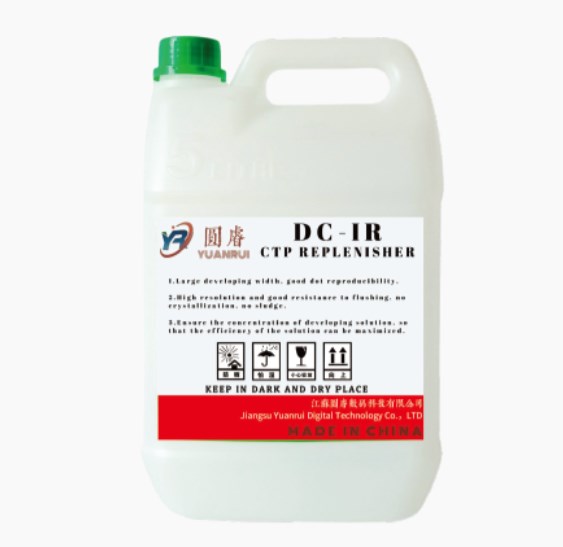2025-10-15
With the rapid development of modern printing technology, CTP (Computer to Plate) platemaking technology has become mainstream in the printing industry. As an indispensable component of this technology, CTP replenishers play a key role in maintaining developer stability, extending developer life, and ensuring plate quality. With increasing demands for environmental protection, efficiency, and precision in printing production, the research and development and application of CTP replenishers are gradually becoming a focus of industry attention.
The Core Principles of CTP Platemaking Technology and the Role of Replenishers
CTP platemaking technology directly transfers image information to the printing plate via a computer, eliminating the intermediate steps in traditional platemaking and significantly improving platemaking precision and production efficiency. In this process, the developer is a crucial medium for image development, and the replenisher is a key factor in maintaining the stability of the developer's performance.
Over long-term use, the developer's chemical composition changes due to continuous reaction with the printing plate, affecting development speed and image clarity. The addition of CTP replenishers can replenish the depleted active ingredients in the developer, maintaining its chemical balance and ensuring consistent development results. A stable development environment not only improves the dot reproduction rate of printing plates but also effectively avoids common problems such as image color cast and background graying, thereby ensuring print quality.
CTP Replenisher Fluid Chemical Properties and Performance Requirements
The performance of CTP replenisher fluid is directly related to the stability of the entire platemaking process. High-quality CTP replenisher fluids must be formulated to exhibit excellent chemical stability, low volatility, and strong buffering capacity to withstand fluctuations in developer concentration.
Replenisher fluids typically consist of an alkaline regulator, surfactant, antioxidant, and preservative. These ingredients work synergistically to maintain developer activity even under high-frequency development conditions. Furthermore, with increasingly stringent environmental requirements in modern printing, low-VOC (volatile organic compound) formulas, absence of heavy metal residues, and readily biodegradable ingredients have become key development priorities for next-generation CTP replenisher fluids.

Different CTP plates, such as thermal, ultraviolet, and process-free, require distinct chemical properties for replenisher fluids. Researchers and developers must precisely adjust the pH, concentration, and reaction rate of the replenisher based on the plate's development characteristics to ensure optimal developer compatibility and stability.
Optimizing the Application of CTP Replenisher in Printing Production
In printing production, the amount and frequency of CTP replenisher used must be precisely controlled to ensure optimal developer performance. Adding replenisher too quickly can lead to excessive alkalinity, damaging the plate surface; insufficient replenishment can reduce developer activity, resulting in uneven development and poor image quality. Therefore, properly controlling the replenisher ratio and flow rate is a critical component of printing management.
Modern platemaking equipment is commonly equipped with automatic replenishment systems that automatically adjust the replenishment rate to maintain the developer's equilibrium by sensing changes in the developer's conductivity, temperature, or pH. This intelligent control significantly improves production consistency and reduces manual error.
To ensure replenisher performance, printing plants typically perform periodic maintenance and cleaning of the developer tank to prevent sediment or chemical residues from affecting the chemical reaction balance. Storage conditions for the replenisher are also crucial; it should be kept away from high temperatures and sunlight to prevent oxidation and volatilization.
Development Trends in Environmentally Friendly CTP Replenishers
With the global printing industry's green transformation, the environmental performance of CTP replenishers has become a core competitive advantage. Traditional replenishers often contain strong alkaline or highly polluting ingredients such as sodium hydroxide and ethanolamine. While these ingredients offer strong developing capabilities, they pose certain environmental challenges in wastewater disposal. New environmentally friendly CTP replenishers utilize a milder organic base system combined with low-toxicity additives, making them not only more stable during the developing process but also easier to dispose of in later stages.
The promotion of environmentally friendly formulas not only reduces the emissions burden of printing companies but also enhances their corporate social responsibility image. Especially in Europe, America, and parts of Asia, where printing environmental regulations are becoming increasingly stringent, the use of low-pollution, recyclable CTP replenishers has become an inevitable trend in the industry.
In the future, CTP replenishers will continue to evolve towards intelligence and precision. By using digital monitoring systems to collect real-time developing data and integrating AI algorithms to automatically optimize the replenishment ratio, the developing process will shift from empirical control to data-driven precision control, achieving more stable and efficient platemaking quality.
The Relationship Between CTP Replenisher and Print Quality
The stability of print quality depends not only on the platesetter, plate materials, and developer, but is also directly impacted by the properties of the replenisher. The chemical equilibrium of the replenisher determines the completeness of the development reaction, which in turn affects image gradation, contrast, and dot integrity.
When the active ingredients in the developer decrease due to extended use, if not replenished promptly, the printed image may exhibit blurring, color casts, or unevenness. High-quality CTP replenisher provides continuous chemical support during the developer aging process, maintaining ideal hydrophilic and oleophobic properties on the plate surface, thereby ensuring consistent and stable ink color during subsequent printing.
Although CTP replenisher does not directly participate in the printing image, it plays a crucial role in the platemaking process. It is the invisible driving force that ensures developer stability, plate clarity, and long-lasting print quality. As the printing industry moves towards digitalization and green development, technological innovation and application upgrades in CTP replenisher will continue to drive the printing industry toward higher standards.